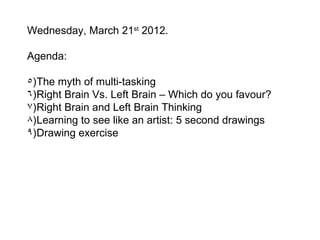Report
Share

Recommended
More Related Content
Similar to Learning to see left vs right
Similar to Learning to see left vs right (20)
Chapter 7Thinking and IntelligenceFigure 7.1 Thinking .docx

Chapter 7Thinking and IntelligenceFigure 7.1 Thinking .docx
Chapter 7Thinking and IntelligenceFigure 7.1 Thinking .docx

Chapter 7Thinking and IntelligenceFigure 7.1 Thinking .docx
Both the brain hemispheres,left right are equally important

Both the brain hemispheres,left right are equally important
More from Naomi Barbagallo
More from Naomi Barbagallo (7)
Recently uploaded
Mehran University Newsletter is a Quarterly Publication from Public Relations OfficeMehran University Newsletter Vol-X, Issue-I, 2024

Mehran University Newsletter Vol-X, Issue-I, 2024Mehran University of Engineering & Technology, Jamshoro
Recently uploaded (20)
Unit-IV; Professional Sales Representative (PSR).pptx

Unit-IV; Professional Sales Representative (PSR).pptx
General Principles of Intellectual Property: Concepts of Intellectual Proper...

General Principles of Intellectual Property: Concepts of Intellectual Proper...
This PowerPoint helps students to consider the concept of infinity.

This PowerPoint helps students to consider the concept of infinity.
UGC NET Paper 1 Mathematical Reasoning & Aptitude.pdf

UGC NET Paper 1 Mathematical Reasoning & Aptitude.pdf
ICT Role in 21st Century Education & its Challenges.pptx

ICT Role in 21st Century Education & its Challenges.pptx
Asian American Pacific Islander Month DDSD 2024.pptx

Asian American Pacific Islander Month DDSD 2024.pptx
Micro-Scholarship, What it is, How can it help me.pdf

Micro-Scholarship, What it is, How can it help me.pdf
ICT role in 21st century education and it's challenges.

ICT role in 21st century education and it's challenges.
Seal of Good Local Governance (SGLG) 2024Final.pptx

Seal of Good Local Governance (SGLG) 2024Final.pptx
Learning to see left vs right
- 1. Wednesday, March 21st 2012. Agenda: 5)The myth of multi-tasking 6)Right Brain Vs. Left Brain – Which do you favour? 7)Right Brain and Left Brain Thinking 8)Learning to see like an artist: 5 second drawings 9)Drawing exercise
- 2. The myth of multi-tasking Major studies now show that: Doing several things at once is just tricking ourselves into believing that we can multi-task but the truth is we don’t actually multi-task, we switch-tasks. Our brains cannot process more than one thing at a time. By multi-tasking we decrease our productivity by up to 40%. When interrupted or distracted from a task, it takes up to 20 minutes to refocus on the original task. Studies have shown that heavy multi-taskers can experience a 10% decrease in IQ. What does that mean for us? When we need to concentrate on our drawing that should be the only thing we are doing.
- 3. http://youtu.be/iZMJeQ4yPPk Left Brain Vs. Right Brain We've all heard people talk about left brain vs. right brain thinking and many people generally think of it as a genetic disposition. In fact, every human being has two modes of thinking, simply put, the logical, symbol oriented way of thinking (left) and the more visual, intuitive approach (right). Although it is true that individuals tend to develop a preference for one mode of thinking over the other, it is possible to train our minds to switch modes. For us left brain inclined types, what we need to do is hone in on the way we perceive the world around us, disable our instinctual need to attach labels and instead, focus on shapes, lines, colors and the relationships between them. This is the only way to accurately translate what is a three dimensional world into a two dimensional drawing.
- 4. The right side of the brain controls your unconscious instincts. Talking is an example of a right brain function. When you talk, you do not think in terms of article-subject-preposition- adjective-adverb-descriptive verb, however when most people draw, this is exactly how they think. To draw a person, you draw a head, a body, two arms and two legs, the hands, the feet, the hair, and the clothes, right? No, those are symbols that you have learned for these things. In short, you are drawing what you think these things are, not what they are. In order to draw well, you must think in terms of lines, shapes, angles and their relationship to other lines and shapes, which combine to create the whole. For instance, a head is an elongated circle and a leg is two long straight lines, bent midway and connected to a triangular-shaped structure, also known as the pelvis and hip bones. Truth be told, we use both modes of thinking all the time, together and independently and we use each mode to interpret the other mode. Your logical mind (left brain) will not accurately portray an object on paper because it will assign a label to the object and attach a restrictive image of said object in your mind. Fortunately, your visual mind will see the very same subject as a series of shapes, lines, dark shading and light shading that intersect in ways and combine to create the whole. Tapping into the ¨right¨ mode of thinking takes a conscious effort, some technique, practice and patience, but once you get the hang of it, you're golden. Most students begin with uncertainty and inaccuracy in their work, not only due to their lack of experience but also from an inability to transmit information from their eye to their hand. What is thought to be seen and what is actually seen is confused because they lack an awareness of the difference between the two and they have not yet honed their ability to identify what they are seeing.
